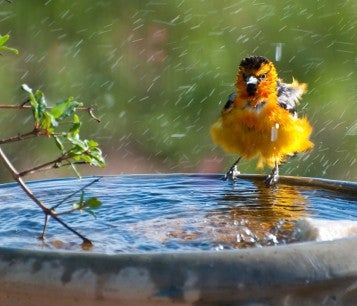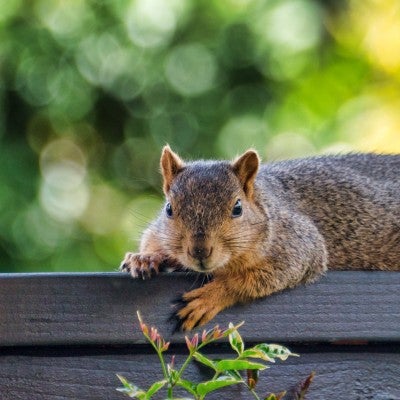A raccoon in the chimney, a groundhog under the shed, a skunk under the back porch … when confronted with wildlife living up-close in their own homes or backyards, well-meaning but harried homeowners often resort to what they see as the most humane solution—live-trapping the animal and then setting them free in a lush, leafy park or other far-away natural area.
It sounds like a good idea, but the sad truth is that live-trapping and relocation rarely ends well for wildlife, nor is it a permanent solution. Why isn’t this approach as humane and effective as it seems and what other options do caring people have when wildlife conflicts arise? Read on for the answers—and some solutions!
Wild nursery
Between March and August, raccoons, skunks, groundhogs and other animals may choose shelter in, around and under a home because they need a safe place to bear and rear their young. Well-adapted to urban life, they will opt to nest in safe, quiet and dark spaces—such as an uncapped chimney or under the back porch steps—if given the opportunity. You may only see one animal, but during this time, assume that any wild animal denning or nesting around a home is a mother with dependent babies.
Unintentional orphans
Not recognizing that dependent young may be present when live-trapping and relocating wildlife during the spring and summer often has tragic consequences. Wild animal babies are unintentionally orphaned and too often die of starvation, because their mother is trapped and removed.
The dangers of relocation
Although homeowners mean well, wild animals do not “settle in” quickly to new surroundings, no matter how inviting that habitat may seem to humans. In fact, the odds are heavily stacked against any animal who is dumped in a strange park, woodland or other natural area.
A 2004 study of grey squirrels who were live-trapped and relocated from suburban areas to a large forest showed that a staggering 97 % of the squirrels either soon died or disappeared from their release area. Take it from the animals' point of view:
- Suddenly in an unfamiliar place, they are disoriented and don’t know where to find shelter, food or water.
- They're in another animal’s territory and may be chased out or attacked.
- They don’t know where to go to escape from predators.
- They may desperately search for babies that they are now separated from.
In the meantime, their helpless young are slowly dying. Even if the orphaned young are discovered, rescued and taken to a wildlife rehabilitator to be reared, it remains a bleak situation for both mother and offspring; one that could have been easily prevented.
No matter how big or small your outdoor space, you can create a haven for local wildlife. By providing basic needs like water, food and shelter, you can make a difference in your own backyard.

Patience, it's a virtue
If you discover a wildlife family nesting in or around your home, the ideal response is patience.
If the animals are not causing damage or harm, you can be assured that once the young are big enough to be out and about, the birth den will have served its purpose. The denning and nesting season is short. Be tolerant and wait a few weeks until the family has vacated the premises and you’ll prevent orphaning of the young altogether. Then you can make repairs to prevent animals from moving in again.
If you can’t wait for the animals to leave on their own, the next best strategy is humane eviction—gently harassing the animals so they’ll move to an alternative location. Wild animals have a sophisticated knowledge of their home ranges (the area in which they spend almost their entire life). Alternative places of refuge are part of that knowledge or cognitive map. Litters can, and will, be moved if disturbed.
Try using a combination of unpleasant smells and sounds. The size of the denning space and the amount of ventilation will largely influence if such repellents will work. We recommend using rags soaked in a strong smelling substance such as cider vinegar (not ammonia), lights and a blaring radio during nighttime hours to convert an attractive space (quiet, dark and protected) into one that is inhospitable.
Excluding unwanted guests
Repellents provide a temporary solution at best. To permanently prevent animals from using those same spots in the future, you’ll need to seal off any denning areas. Make sure all animals are out before sealing off any space. Remember, during the spring and summer months, it is extremely likely that the animal denning under your steps or elsewhere around your home is a female with dependent young. Make sure that mother and young are able to remain together to prevent any of them from dying cruel deaths.
If you can find the entry/exit holes, an easy way to determine if the den has been vacated is to loosely cover or fill it with a light material, such as newspaper or insulation. This way the occupant will have to push the obstruction aside to get out or come back in. If the block hasn’t moved for three to four days (and it’s not the dead of winter), the den has been vacated and it’s safe to make repairs.
These suggestions are general guidelines only. Recommended methods for resolving conflicts with wildlife may depend upon additional aspects of the situation and the species involved.
But what if ... ?
When the only other option is killing, we sometimes agree that relocation, which gives the wild animal at least a chance, is acceptable. Much depends on the species involved, the time of year, the area into which relocation occurs and other factors—too many to write a general prescription.
For example, relocating an opossum, an animal that tends to wander all its life and often has no fixed home range (and carries their babies with them), could be seen as more acceptable than relocating a squirrel in mid-winter. For squirrels, it is a death sentence, since they would no longer have access to their food cache on which they survive the winter. There are times and circumstances when relocation is surely a better alternative than certain death.

